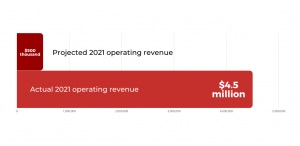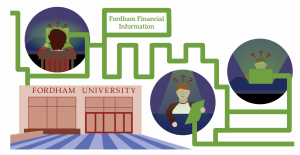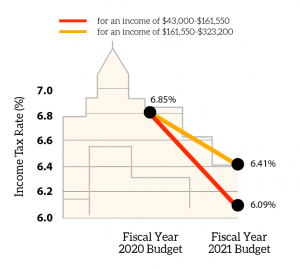Fordham’s Finance Team Discusses Fiscal Year 2023
Unlike previous years, the next fiscal year will operate under an all funds budget for the first time ever
May 24, 2022
The Office of Finance held a budget forum on May 13 announcing its operating plans for the 2023 fiscal year. Fordham’s Senior Vice President for Finance, Chief Financial Officer and Treasurer Martha Hirst and Nicholas Milowski, vice president for finance and assistant treasurer, hosted the forum, looking back on Fordham’s 2022 fiscal year as it comes to a close in six weeks.
Hirst began the forum by explaining how the university’s budget for the past two calendar years, which encompassed fiscal years 2020, 2021 and 2022, has been centered on crisis management due to the pandemic’s effects on the university’s finances.
“The period from spring 2020, from the week of March 8, 2020, to be exact, until now has of necessity been more keenly focused on immediate budget management and very near term planning,” she said. “We were in crisis with all manner of possible scenarios to contemplate here at Fordham.”
In her introduction, Hirst noted that Fordham has come through the 2022 fiscal year quite well due to careful budget management and forecasting.
Reviewing the 2022 Fiscal Year
When preparing the 2023 fiscal year budget, the finance team looked at expected revenues and enrollment targets to develop an understanding of the anticipated federal financial aid numbers. Planning for the fiscal year also included determining the undergraduate tuition rate, which was announced to increase by 4% for the 2022-23 academic year in an email sent to the Fordham community from University President Rev. Joseph M. McShane, S.J., on May 13.
The finance team also identified additional resources, needs and priorities when planning the budget, which included the cost of the newly renovated Joseph M. McShane, S.J. campus center as well as support for mission and ministry, contractual and agreement based salary increases, and some inflation, according to Hirst.
The sum of anticipated revenues and expenses the university predicted resulted in a $30 million gap between the two, leading to a proposed withdrawal of almost $6 million from the position of the endowment to support the operating budget, Hirst added.
“This is a temporary measure and an unusual step, but one that reflects the somber state we are in at this juncture in the year when we lose the federal funds we have been relying on and when inflation is climbing as it is,” she said.
The university’s operating expenses grew a bit due to a variety of factors, such as the increase in the student population, COVID-19 and Hurricane Ida. Additional resources were required to ensure there were enough academic courses, space to house students in residence halls as well as the cleaning of facilities and other expenses associated with having more people on campus, according to Hirst.
Although Fordham incurred these additional expenses, it is ending the year with a positive operating result of $3.2 million. Hirst added that the operating result is “not a very big number when you think about us being a half a billion dollar enterprise.”
The 2023 fiscal year budget will look different compared to the 2022 fiscal year, as, for the first time, it will operate on what the university’s finance team referred to as an all funds budget.
According to Hirst, the transition from McShane’s presidency to president-elect Tania Tetlow will require a reexamination of the finance team’s strategies, processes and practices around budgeting, pricing, financial aid, revenue generation and labor relations.
The New All Funds Budget
The 2023 fiscal year budget will look different compared to the 2022 fiscal year, as, for the first time, it will operate on what the university’s finance team referred to as an all funds budget. An all funds budget consists of the traditional operating budget Fordham already uses in addition to direct donor contributions and government grants.
“The all funds budget that we are arriving at this year is a budget that takes into consideration all of the sources and uses of funds that flow in and out of the university and subjects those funds to the same level of budgetary controls that our traditional operating budget has always been subjected to,” Milowski said when he outlined the process of developing revenue estimates.
Milowski added that the benefit of an all funds budget is that it encourages a more holistic thinking about the funds available for the university’s use.
Milowski added that the benefit of an all funds budget is that it encourages a more holistic thinking about the funds available for the university’s use.
Undergraduate Tuition Rate Increase
The tuition rate increase was announced in the budget forum prior to the email McShane sent to the university community. Milowski referenced a headline from Inside Higher Ed regarding tuition rate increases across universities driven by rising inflation. Fordham’s tuition rate increase for the 2022-23 academic year is 4%, but Milowski noted that this increase does not take into account the benefits that financial aid offers to students and families.
“We are giving most first-year incoming undergraduate students a 50% reduction off of their sticker price, and that is something that we believe to be very important for our mission,” he said.
An important factor, according to Hirst, when considering the undergraduate tuition rate was the growth of financial aid.
Milowski added that although the university had an 8.3% consumer price index report as of May 12, Fordham is not raising tuition at that rate because it would not be in line with the university’s mission and would not be sensible for the university’s business model.
“In a sense, the 4% undergraduate tuition rate increase is compensating for a much longer period of no tuition rate increases,” he said. “We can not control inflation but we certainly believe that inflation should not necessarily be passed all the way through to our students in our community.”
An important factor, according to Hirst, when considering the undergraduate tuition rate was the growth of financial aid. Financial aid is increasing at 5.3% while tuition growth is 3.5%.
Hirst also added that the finance team wants to ensure Fordham is kept as affordable as possible for students and their families and noted that the university will not do more than it has to in order to maintain the institution and grow it in positive ways.
“The money going out cannot be bigger than the money coming in or else over time we will dry up,” Hirst said. “I do not say that to be dramatic. I say that just to point out the importance of the sustainability of these relationships.”
Hirst also added that the finance team wants to ensure Fordham is kept as affordable as possible for students and their families and noted that the university will not do more than it has to in order to maintain the institution and grow it in positive ways.
She concluded the forum by thanking everyone for attending the event, as well as for their help in managing the difficult year.
“The success and the financial stability are all based on the entire community’s efforts coming together,” Hirst said.
The Office of Finance will hold another budget forum in the fall.















